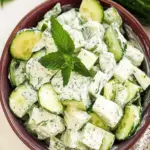Making your own sourdough bread is not only rewarding but also fills your home with the delightful aroma of freshly baked bread. This classic recipe yields a golden-brown loaf with a perfect crispy crust and a soft, chewy interior, making it an absolute favorite among bread lovers. Sourdough bread is incredibly versatile and can be enjoyed in various ways, from slathering it with butter or jam to using it for sandwiches or dipping in soups. With a bit of patience and the right technique, you can enjoy a loaf that’s as good as anything from your favorite bakery.
Full recipe:
Ingredients:
-
500g bread flour
-
350g water (lukewarm)
-
100g sourdough starter (active)
-
10g salt
Directions:
-
In a large mixing bowl, combine the flour and water, mixing until a shaggy dough forms.
-
Let the dough rest for 30 minutes (this is called the autolyse stage).
-
Add the sourdough starter and salt, then mix well until fully incorporated.
-
Knead the dough for about 10-12 minutes until it becomes smooth and elastic.
-
Place the dough in a clean bowl and cover it with a damp cloth. Allow it to rise for 4-6 hours or until it has doubled in size.
-
Turn the dough onto a lightly floured surface and gently shape it into a round loaf.
-
Place the dough onto a parchment-lined baking sheet and cover it with a cloth. Let it rise for another 1-2 hours.
-
Preheat your oven to 475°F (245°C) with a baking stone or Dutch oven inside.
-
Once the dough has risen, score the top with a sharp knife or razor blade.
-
Bake the bread for 30-35 minutes, or until the loaf sounds hollow when tapped on the bottom and has a golden, crispy crust.
-
Let the bread cool completely before slicing.
Prep Time: 15 minutes | Cooking Time: 40 minutes | Total Time: 6-8 hours (including rise time)
Kcal: 120 kcal per slice | Servings: 10 slices
Introduction
Sourdough bread is a timeless and beloved recipe that has been around for centuries. Its rich, tangy flavor and distinct texture set it apart from other types of bread. Whether you’re a seasoned baker or someone just starting out, making your own sourdough bread from scratch is an incredibly rewarding experience. This article will explore why sourdough bread is so special, the history behind it, and the step-by-step process to make it. If you’re looking for a recipe that combines both flavor and tradition, this homemade sourdough bread recipe is the perfect place to start.
The History of Sourdough Bread
Sourdough bread is one of the oldest forms of leavened bread in the world, dating back to ancient Egypt around 1500 B.C. The method of sourdough fermentation likely began when wild yeast and lactic acid bacteria naturally found their way into flour and water mixtures, causing them to ferment and rise. Over time, this process evolved, with bakers harnessing the natural microorganisms to create bread with a unique flavor profile and texture.
Sourdough was historically a staple in many cultures due to its ease of preparation and the preservation qualities that the fermentation process provided. In fact, sourdough was so significant that it was commonly used in European regions, and the tradition of making sourdough bread continued to be passed down from generation to generation. The rise in popularity of commercial yeast in the 19th century shifted attention away from sourdough, but it has experienced a renaissance in recent years as people seek more artisanal and homemade options.
Why Sourdough Bread is So Special
Sourdough bread is different from other types of bread primarily due to the way it’s leavened. Rather than using commercial yeast, sourdough relies on a naturally occurring mixture of wild yeasts and lactic acid bacteria. This fermentation process is what gives sourdough its distinct tangy flavor and chewy texture. Not only is it flavorful, but sourdough has several benefits that make it stand out among other breads.
1. Better Digestibility
The fermentation process in sourdough breaks down some of the gluten in the dough, making it easier to digest for many people compared to traditional bread. The natural bacteria in sourdough also help to break down the phytic acid present in the flour, which can interfere with the absorption of minerals like calcium and magnesium. As a result, sourdough is often considered more nutritious and gentle on the digestive system.
2. Probiotic Benefits
Since sourdough is naturally fermented, it contains beneficial bacteria (lactic acid bacteria) that contribute to gut health. These probiotics can aid in digestion and help maintain a balanced gut microbiome. Consuming foods with probiotics can boost your immune system, support digestion, and even improve your skin health. While baking at high temperatures will kill some of these probiotics, sourdough bread still provides many digestive benefits compared to non-fermented bread.
3. Lower Glycemic Index
Compared to traditional bread, sourdough has a lower glycemic index (GI), meaning it causes a slower rise in blood sugar levels. This is primarily due to the organic acids and bacteria in the sourdough that alter the structure of the bread. As a result, sourdough may be a better choice for individuals looking to maintain stable blood sugar levels.
4. Long Shelf Life
One of the unique qualities of sourdough bread is its long shelf life. Due to the lactic acid bacteria present in the bread, sourdough has natural preservatives that help prevent it from going stale quickly. Additionally, the high acidity in the dough also inhibits the growth of mold, which is a common problem with many commercial breads. This makes sourdough an excellent option for those who want a loaf that stays fresh longer.
The Process of Making Sourdough Bread
Making sourdough bread can seem intimidating at first, but with a little patience and practice, you can create a delicious loaf in the comfort of your home. The recipe provided earlier outlines the basic steps, but here’s a more detailed breakdown of each stage.
Creating the Sourdough Starter
A sourdough starter is the key to making great sourdough bread. It’s essentially a mixture of flour and water that encourages wild yeast and bacteria to grow and ferment. The starter takes a few days to develop, requiring regular feeding of flour and water to maintain the fermentation process. It’s important to use a healthy and active starter to ensure that your bread rises properly. You can either create your own starter or obtain one from a friend or a bakery.
Mixing and Kneading the Dough
Once you have your starter ready, it’s time to mix the dough. Combine flour, water, salt, and the starter in a large mixing bowl, and mix until you have a shaggy dough. After this, the dough will need to be kneaded to develop the gluten. Kneading helps the dough become elastic and ensures a nice crumb structure in the final loaf.
Bulk Fermentation
This is where the magic of sourdough fermentation happens. After kneading, the dough should be left to rise in a warm, covered space for 4-6 hours, or until it has doubled in size. During this time, the wild yeast and bacteria will feed on the sugars in the flour and cause the dough to ferment, developing the flavor and texture that makes sourdough so special.
Shaping and Final Proofing
After the dough has risen, it’s time to shape it into a round or oval loaf. The dough should be handled gently to avoid deflating the air pockets created during fermentation. Once shaped, the dough is left to rise again for 1-2 hours, known as the final proof. This stage ensures that the bread will rise properly in the oven and achieve a light and airy texture.
Baking the Bread
Preheat your oven to a high temperature, typically around 475°F (245°C), and bake the bread for 30-35 minutes. The high heat will create a beautiful, crispy crust while the interior remains soft and airy. Once baked, let the bread cool completely before slicing. This allows the crumb to set properly and develop its full flavor.
Tips for the Best Sourdough Bread
To ensure that your sourdough bread turns out perfectly, here are a few helpful tips:
-
Use high-quality flour: The flour you choose plays a significant role in the quality of your bread. Bread flour or high-protein flours are ideal for sourdough as they provide the necessary gluten structure for a good rise.
-
Keep the starter active: A healthy, active starter is essential for a successful loaf. Feed your starter regularly with equal parts water and flour to keep it bubbly and strong.
-
Don’t rush the fermentation process: Sourdough requires time and patience. Allow the dough to ferment and rise at its own pace to achieve the best flavor and texture.
-
Maintain the right temperature: The ambient temperature plays a big role in fermentation. Try to keep the dough in a warm, draft-free spot, ideally between 75°F and 80°F (24°C – 27°C).
Why This Recipe is the Best
This particular sourdough recipe is ideal for beginners and experienced bakers alike. The process is straightforward and uses simple ingredients, yet the result is a beautifully crusty, flavorful loaf of bread. It strikes the perfect balance between tanginess and a soft, chewy interior. This recipe doesn’t require any special equipment like a Dutch oven (though it can help), and it doesn’t involve a lot of complicated steps, making it perfect for anyone looking to make sourdough at home.
Furthermore, the benefits of making your own sourdough are numerous. Not only will you enjoy the satisfaction of creating something from scratch, but you’ll also know exactly what goes into your bread. There are no preservatives or additives—just pure, wholesome ingredients. Plus, homemade sourdough has the added benefit of being customizable. Feel free to experiment with different types of flour, hydration levels, or even add-ins like seeds, herbs, or dried fruit.
Conclusion
In conclusion, making homemade sourdough bread is not just about baking a loaf—it’s about connecting to a centuries-old tradition, learning the art of fermentation, and enjoying a nutritious, flavorful bread that’s far superior to anything you’ll find at the store. The process requires patience, but the rewards are well worth it. The crusty exterior, the soft and tangy interior, and the satisfying flavor of homemade sourdough bread will elevate any meal. Whether you enjoy it on its own with butter, use it for sandwiches, or pair it with your favorite soups, this bread is sure to become a staple in your kitchen. So, roll up your sleeves, gather your ingredients, and start baking today!






